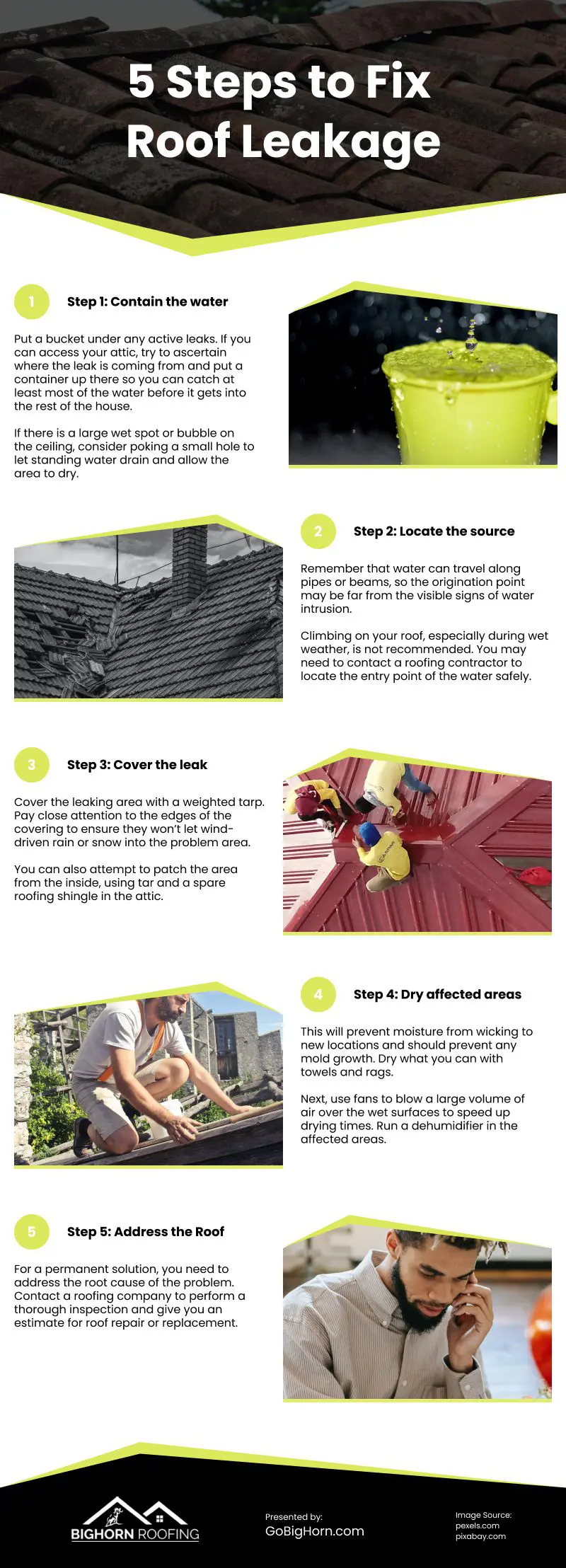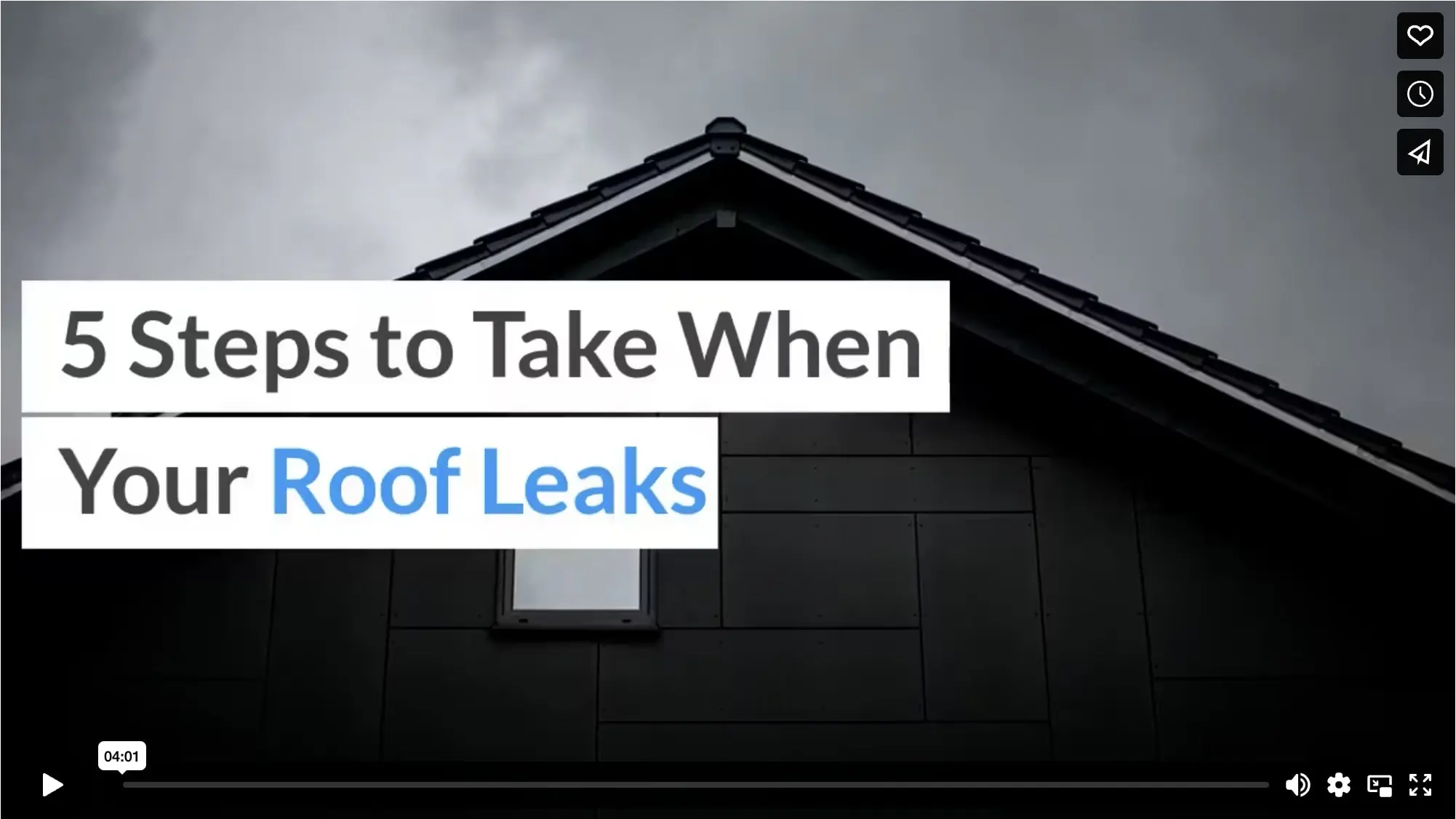It’s raining outside. You just want to curl up under a blanket with a mug of your favorite hot beverage. Except when you go to the cabinet to grab that mug, you notice a wet stain on the ceiling, or worse yet, a puddle on the floor. So much for your relaxing rainy day. You’ve got a roof leak. That’s no reason to panic, but you do need to act quickly.
These are the five steps to ensure it is taken care of properly and doesn’t cause even more expensive damage.
Step 1: Contain the water
The first thing you want to do is contain the damage. Put a bucket under any active leaks. If you can access your attic, try to ascertain where the leak is coming from and put a container up there so you can catch at least most of the water before it gets into the rest of the house. Check your receptacles frequently to prevent overflows if it is a heavy leak.
If there is a large wet spot or bubble on the ceiling, consider poking a small hole to let standing water drain and allow the area to dry. You will want to relieve the pressure on that bubble as soon as possible. Not only can it spread, but the weight of the accumulating water could cause a portion of your ceiling to collapse. Water will continue to flow until you stop the leak, so leave a bucket under the area.
Step 2: Locate the source
That water is getting into your home somehow. Try to determine where it is coming in. Remember that water can travel along pipes or beams, so the origination point may not be directly above the visible signs of water intrusion. Also, keep in mind that you may have more than one leak. Don’t stop looking after you’ve found one water source.
Climbing on your roof, especially during wet weather, is not recommended. You may need to contact a roofing contractor to locate the entry point of the water safely. They will know what to look for and see subtle signs of problems you might overlook. Sometimes the source of the problem can be less than half an inch, so it takes an expert eye to locate it.
Step 3: Cover the leak
Until you can properly address the problem, you need to prevent more water from coming in. Cover the leaking area with a weighted tarp. Pay close attention to the edges of the covering to ensure they won’t let wind-driven rain or snow into the problem area. Remember that roofs are dangerous and can be slippery when wet, so proceed cautiously if you attempt this. If you prefer, you can have a roofing contractor come tarp your roof.
You can also attempt to patch the area from the inside, using tar and a spare roofing shingle in the attic. Repeat this step for each area of concern. These temporary fixes will hold you over until step four.
Step 4: Dry affected areas
Now that you’ve stopped the problem from getting worse, you can work on drying out any wet areas. This will prevent moisture from wicking to new locations and should prevent any mold growth. Dry what you can with towels and rags.
Next, use fans to blow a large volume of air over the wet surfaces to speed up drying times. Run a dehumidifier in the affected areas. Temporarily turning up your heat can also supply drier air. Placing a space heater near water-intrusion areas can also help them dry but, as always, be mindful of using electrical equipment near water.
Step 5: Address the Roof
All the above steps treat the symptoms, but if you stop there, you will likely be dealing with more leaks the next time it rains. For a permanent solution, you need to address the root cause of the problem. Contact a roofing company to perform a thorough inspection and give you an estimate for roof repair or replacement.
If it makes you more comfortable, you can work with several Salt Lake City roofing contractors to get multiple quotes and repair plans. But don’t delay too long, as the damage to your roof or siding and to the inside of your home may worsen with each subsequent rain, increasing your costs and stress. You could also eventually see mold growth, which can be expensive to remediate and bad for your health. The sooner you can solve the problem, the better.
You may also need to repair drywall, wood floors, or other surfaces damaged by the wait. Wait to perform this work until your roof repair company has completed their job. This ensures the problem is solved at the source and won’t reappear and redamage those areas during the next rain.
A leaking roof is stressful, but using these steps can prevent further damage and expense, and ensure the leak is properly addressed. They will get you back to enjoying that warm beverage and the pleasant sound of rain on your water-tight roof.
Infographic
It’s pouring outside, and all you want to do is curl up. However, when you go to get that mug from the cabinet you discover a leak in your roof. There’s no need to freak out, but you must act right away. The five actions listed should be followed to ensure that your roof is treated properly.

Video

